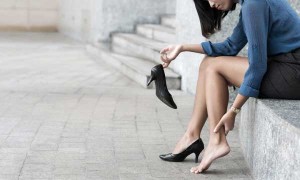A dance medicine doctor tackles high heel harm
If you’re among the many who can’t—or won’t—say no to stylish but uncomfortable high heels, Sajid A. Surve, DO, knows all about your pain.
Dr. Surve, co-director of the Texas Center for Performing Arts Health and an associate professor at the University of North Texas Health Science Center Texas College of Osteopathic Medicine, helps dancers and other frequent heel wearers counteract the head-to-toe toll high heels can take on the body. He treats high heel pain daily, taking a whole person approach to help performers avoid long-term harm.
Proper alignment
Focusing on whole-person care, doctors of osteopathic medicine, or DOs, look beyond your symptoms to consider how environmental and lifestyle factors impact your health. With advanced knowledge of the musculoskeletal system, DOs also believe that the body performs better when it is in proper alignment. By partnering with their patients to help them get healthy and stay well, they can help them avoid injuries and high heel pain.
“From an osteopathic perspective, we’re looking for the body to be centered from head to toe. High heels put the foot at an angle and pull muscles and joints out of alignment, so the effects aren’t limited to the feet,” Dr. Surve explained. “It’s not unusual for people who spend lots of time in high heels to have low back, neck and shoulder pain because the shoes disrupt the natural form of the body.”
Structurally, the plantar fascia in the foot is connected to the calf muscle, which in turn connects to the hamstring. The hamstrings attach to the pelvis and low back, which is why wearing high heels can make your back ache along with your feet. Also, walking on the balls of your feet will shift your center of gravity forward, forcing you to arch your back when you stand and further contributing to back pain.
The high heel stretch
Regular stretching of the plantar fascia and calves will loosen hamstrings and work to alleviate back pain from your high heels. Dr. Surve recommends stretching before and after long periods in heels and sneaking in some foot work during breaks in your day.
Try this stretching routine during your next break:
- Lay a book with a one-inch spine on the floor.
- While standing, place the ball of your right foot on the book and rest your heel on the ground.
- Bend forward at the waist and try to grab the toes on the book. (If you need to bend your knees a little, that’s OK).
- Hold for 30 seconds.
- Switch feet. Repeat two to three times.
- Gradually increase the height of the book by 1-inch increments per week to a maximum of 3 inches.
It’s also important to understand that the slope of the shoe is more crucial than heel height when it comes to comfort, Dr. Surve notes. Look for a platform sole to decrease the angle between the heel and the ball of the foot, so your weight can be more distributed across the entire foot. A thicker heel also spreads your weight more evenly and decreases the risk of spraining your ankle.
Also, avoid narrow toe boxes that squeeze toes. Narrow, pointy high heels are the perfect storm for foot pain, according to Dr. Surve. Ideally, a pointed shoe will narrow after the toe box to give the illusion of length while providing ample space for your foot.
Finally, high heels should fit snugly and hold the foot firmly in place. High heels that are slightly loose cause your foot to slide back and forth. That friction is the culprit behind blisters, bleeding feet and ripped toenails, according to Dr. Surve.

